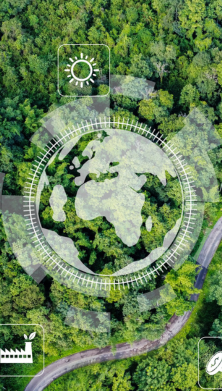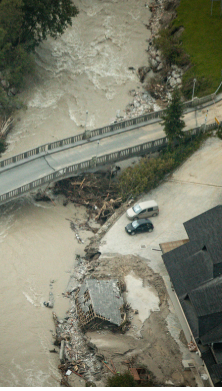- The 29th 'Les Rencontres' conference hosted by AMRAE, the French Risk Management Association, is a three-day conference and consists of a variety of keynote speeches, panel sessions and round table discussions.
- This year the main theme is sustainability and societal inclusion against the backdrop of the pandemic and increasing polarization. The event takes place in person in Deauville, France, using stringent covid precautionary measures.
- Joachim Müller, Allianz Global Corporate & Specialty (AGCS) CEO, has been invited as one of the keynote speakers. His speech is available to read here.
Joachim Mueller, CEO Allianz Global Corporate & Specialty SE – keynote speech at AMRAE conference on February 2, 2022

Joachim Müller at the AMRAE 2022 conference
"Thank you, Monsieur Beytout, for the kind introduction. Thank you also to AMRAE President, Monsieur Wild, and indeed to you all for the invitation and the opportunity to speak here today.
When I was invited to join you at this distinguished gathering, I made a careful note of the title of this year’s event: Prendre les risques d’un nouvel élan. That’s an interesting theme, because it is hard to translate into English, and believe me, equally hard to translate into German! Taking risks…that’s clear. But ‘élan’? That translates in English into ‘élan’, and guess what, in German, it translates into….‘élan’!
So it looks like élan is really a genuine French characteristic and élan – or agility according to the business jargon en vogue – is really what we need to respond to the new risk landscape.
And how we – the collective community of risk managers, insurers, and brokers – can respond to this new landscape is what I would like to talk about today.
We have heard earlier from the distinguished guests about the big picture, but I now would like to approach our joint challenges from my perspective as an industry practitioner – a player in the market – and at eye level with colleagues here who work in this industry, day in, day out.
Because there’s no doubt: The big world out there is ever more challenging, and at the same time our world and indeed the special segment of corporate insurance and risk transfer is mirroring these challenges. So I would like to look at both sides today – how we as the insurance and risk management community navigate the current risk environment, but also how we at Allianz Global Corporate & Specialty manage our own business and relationships against the backdrop of the wider risk landscape.
After all, we share common interests, although sometimes some of you can be forgiven for questioning that! And if we share interests so closely, why is it sometimes so hard to find the right solutions?
But the reality is that we all want the same outcome: At Allianz we talk about ‘securing your future’; here at AMRAE you refer to risk management as ‘a virtuous process that protects the company, its employees and partners, including insurers’. Collectively, making organizations more resilient, enabling progress and innovation is in our mutual interest.
And this has never been more important. I hardly need to tell you how increasing uncertainty and volatility are the norm now, as the previous speakers and panelists have highlighted: the up and down of Covid-19 waves, climate change and extreme weather events, the surge in ransomware, increasing social unrest and protests, major disruption in supply chains, and inflation. These trends are all prominent for businesses according to this year’s Allianz Risk Barometer – to which many of you also contributed.
It's a new world, a changing world. And this new situation requires a new response. Not just from insurers, but from business as a whole – and naturally the risk management industry should be at the forefront of this. It’s not an easy journey – because it requires transformation, not just in what we do on our own, but also in how we work together. Because partnership, collaboration and joint efforts are for me at the center of this.
Wait! I can imagine many of you are raising an eyebrow – what is this about partnership? We have just come through not one, but two tough renewal seasons.
I want to explain this by starting in my own backyard – at AGCS. Let me explain the journey we have gone through in the past few years because it illustrates what can easily happen – and did happen to others – in our industry and the consequences for all concerned. And the hard decisions that have to be made, decisions which are rarely popular but which, like strong medicine, are absolutely needed, because they create the foundation on which healthy sustainable relationships can be based.
Let’s turn back the clock to 2020, if you can bear it. By the end of that year, AGCS had seen an average Combined Ratio of 106% in the five preceding years. This means we had been losing €6 for every €100 of premium we received. And in 2020 we wrote more than nine billion Euros in gross written premium.
I don’t want to do the math again, believe me, but the point is that both attritional and large losses had been steadily rising and these adverse loss trends together with a decade of soft pricing had eroded our reserves and capital base drastically. Losses accumulated and where our portfolio was over-exposed such as in auto recall for example, we paid the price accordingly. The end result? An unsustainable position, culminating in a massive reserve strengthening from our shareholder.
We had to take a long hard look at ourselves. This could not continue. There was no alternative to a fundamental repositioning of our portfolio, and indeed a transformation of our business.
As a result, we have been investing heavily in pricing, modelling, portfolio management capabilities and predictive analytics to get a more granular view of our portfolio and defined clear target sectors and segments where we can really make a difference to our clients. Also as a consequence, we abandoned business volume of EUR 700 million in the past two years – here I mean rebalancing of segments and regions – and also took corrective underwriting actions on individual accounts. This turnaround of our portfolio was certainly a stress test for many client relationships, and led to unwelcome surprises and many difficult conversations.
Why did we do all this? Like any other business, we need to operate on a profitable basis to be a sustainable and predictable partner for companies and brokers for the long term – this is the foundation so that we can absorb volatility from large loss events in a measured and reliable way.
You should be able to pass your volatility to us, and not see that reflected in wild swings of appetite or pricing from year to year – what I call ‘negative surprises’. This is important for us. In fact, it is our key ambition for AGCS to avoid negative surprises.
Now our book is re-balanced and this major remediation phase is past. We now have clarity what risks we want to underwrite for what terms and conditions and appetite, and we are also ready to target new growth opportunities.
But underwriting excellence alone is not enough. We also have to continuously reduce complexity and costs to offer attractive solutions in the long term and invest in better services which add value to our customers. Take multinational programs for example. Here we see real potential to support businesses in navigating their risk portfolios with better solutions, and we are currently focusing a lot of effort on this, also with input from some clients here in this room.
This wider transformation of AGCS is a journey, which takes time. But our foundations are complete to make us a much more predictable and reliable carrier for the long-term. This is the basis for a sustainable long-term partnership based on mutual understanding.
Enough now on AGCS and our segment. I use this to illustrate the challenge for one company – including the self-reflection we had to do – and hopefully to build understanding of the necessity for change. Let’s now widen our scope and look at the overall risk environment – and I want to use climate change as a leading example of how our industry has to transform to meet the challenge. And this transformation can only come through a new spirit, a spirit of partnership.
2021 was another sad record year: It was the Earth’s sixth-hottest year on record and we also saw record levels of natural disasters and weather losses which were increasingly stemming from so-called secondary perils such as deep freezes, droughts and wildfires, storms, and heavy rain.
We all have the pictures of the floods in Germany and Benelux this summer before our eyes. Cars and houses were washed away by heavy rain and massive landslides so intense that part of the historic villages and even the castle in Erfstadt, near Cologne, were carried away. More than 220 people died in Germany and Belgium. The affected regions may not have seen rainfall of this magnitude in the last 1,000 years.
Our friends at Aon tell us that 2021 is likely to be the fourth time in five years that global natural catastrophes have cost more than $100 billion in insured losses. And according to the French Insurance Federation, last year’s floods in June here in France triggered claims of €550 million. Sadly, these are the ‘new normal’ headlines.
We all know that this increasing trend is driven by climate change and more humidity in a warmer atmosphere. A warming climate may cause stronger cyclones; more intense rainfall and flooding (especially flash floods); more intense convective storms; longer and more severe bushfire seasons.
Further, we can expect to see events occur in areas where they have previously not been experienced or out of the normal season – cyclone and hail zones are expected to move poleward, and bushfires will occur in regions not previously vulnerable for fires and many regions will see more rain and storms.
It's exactly this physical loss impact of weather events that the risk management community is most concerned about. This is the key finding of a recent AMRAE survey and is also confirmed by the Allianz Risk Barometer.
The key question is: How can we avoid an increasing protection gap and maintain risk transfer despite the rising risks of natural catastrophes and weather events? And how can we combat climate change to limit global warming and prevent worst-case scenarios for our planet? Again, this is about partnership, mutual understanding and joint efforts. We have to work together to better understand the increasing and changing exposures and become more resilient, operationally and financially.
The rising likelihood of secondary perils is causing us to further upgrade our modelling and technical approach to these risks. So-called unmodelled risks are rather like a best-bet approach for which we better go to Casino Barrière next door – which I don’t think is acceptable for a technical underwriting business. We need to invest into technology and data to replace the common rear-mirror claims analysis with a forward-looking approach to get ahead of the loss trends and to steer our portfolio in a sustainable way … and we have to share this insight with clients.
Indeed more transparency on both sides is essential. We often say that better data is needed from clients to help us model and underwrite risks, not just about their own risks but also about their critical suppliers.
Easier said than done, because this needs strong connections to internal and external stakeholders, for example for contingent business interruption. But I also believe that underwriting should not be a ‘black box’. We need to explain our position and the rationale of our decision making, and do that in advance, to build mutual understanding. In business, as in all relationships, silence is not golden. Dialogue is essential because all parties must do their part. That is after all the nature of a partnership.
Once we have understood our exposures, effective risk mitigation is key. The old saying ‘Prevention is better than cure’ remains as true as ever, but you all know that risk management is about prevention and cure: risk mitigation up front, and robust protection after an incident.
What’s more, companies should demonstrate their risk management strategy as a core part of their corporate DNA, from top management to employees, and culturally as well as tactically. We insurers must help our customers defining minimum requirements and sharing best practices to become weather-proof – both in regard to physical damage and business continuity.
This will be about continuously upgrading physical site protection, establishing monitoring and early warning mechanisms, and bringing business continuity management and crisis planning to the next level including regular testing.
As an insurer we want to support and reward our clients for effective risk mitigation, so we look for a strong culture of learning and improvement. I think many of you will agree that the strongest partnerships with insurers often arise from the risk consulting side where real benefits can be created from an open exchange early in the underwriting process.
Effective risk mitigation measures will enable sustainable risk transfer. We at AGCS are committed to provide coverage for natural disasters as this is at the heart of the insurance value proposition.
However, as I have explained it’s needs to be a fair deal for both sides, based on comprehensive understanding of exposures and risk mitigation, prevention and cure. Capacity is nonetheless restricted and is likely to remain so for the more technical and highly rated insurers. This means companies should also be ready to have more ‘skin in the game’ through higher self-retention or captives.
Insurers deliver the most value for the ‘big hits’ and not attritional losses. It also requires a new approach to program design – so, for example, smaller primary layers are likely, with additional excess layers to build depth of coverage. Given the sheer scale of climate change risk, risk transfer solutions beyond traditional insurance may also needed: this can mean placing catastrophe and weather risk via alternative risk transfer and capital markets, or even establishing private-public-partnerships or governmental backstops.
Last but not least, to address climate change, our partnership has to go beyond risk transfer. We all need to work together to limit global warming to 1.5 degree Celsius and prevent the worst-case scenarios for our planet and indeed our children and grandchildren. Many companies in this room are developing low carbon strategies for their business, striving for climate neutrality in their operations and products, exploring new green technologies and making substantial sustainability commitments. This is undoubtedly an ambitious transformation for carbon-intense industries.
As investors and coverage providers, insurers are also an important player to drive the transition to a low-carbon world – and Allianz aims to take a leading role. One key action is our commitment to exit coal-based business models. We have started restricting coal in 2015, aim to make significant progress until 2030 and target no coal in our investment and insurance portfolios in 2040.
This is not an easy process and requires tough decisions on both ends. But we are supporting all clients who are committed to the low-carbon transition and have a clear plan; and also provide more capacity and solutions to the green energy sector including new technologies such as hydrogen.
We strongly believe that a net zero future is possible. A continuous dialogue, clear communication on thresholds and timelines, a recognition of the progress and a gradual step-by-step transition in partnership will lead the way. Again, openness and mutual understanding are essential.
It’s all about partnership and collaboration in the big and the small, in each single annual renewal and in the long-term sustainability journey. As a global society, together we have to tackle the enormous challenge of creating a net-zero future for our planet and the coming generations. And in our industry, we also need a fundamental change: from the price-driven transaction-based old school approach to a new partnership.
A new partnership which is based on strong technical insight in risk management and underwriting, underpinned by dialogue and transparency – a partnership that indeed delivers value for both parties as well as resilience for the future.
Let’s start 2022 in this spirit."
Press Contacts
About Allianz Global Corporate & Specialty
Allianz Global Corporate & Specialty (AGCS) is a leading global corporate insurance carrier and a key business unit of Allianz Group. We provide risk consultancy, Property-Casualty insurance solutions and alternative risk transfer for a wide spectrum of commercial, corporate and specialty risks across 10 dedicated lines of business.
Our customers are as diverse as business can be, ranging from Fortune Global 500 companies to small businesses, and private individuals. Among them are not only the world’s largest consumer brands, tech companies and the global aviation and shipping industry, but also satellite operators or Hollywood film productions. They all look to AGCS for smart answers to their largest and most complex risks in a dynamic, multinational business environment and trust us to deliver an outstanding claims experience.
Worldwide, AGCS operates with its own teams in 31 countries and through the Allianz Group network and partners in over 200 countries and territories, employing around 4,400 people. As one of the largest Property-Casualty units of Allianz Group, we are backed by strong and stable financial ratings. In 2020, AGCS generated a total of €9.3 billion gross premium globally.





















